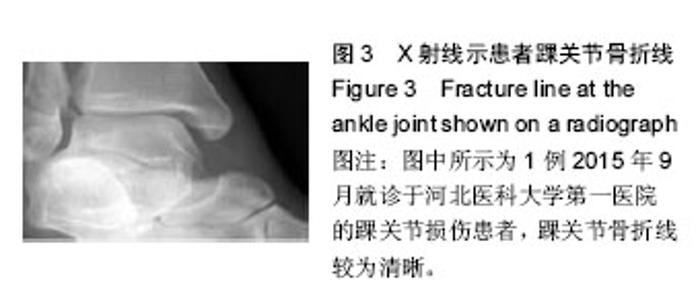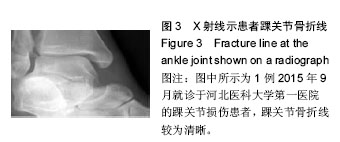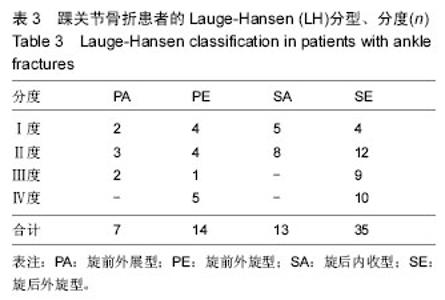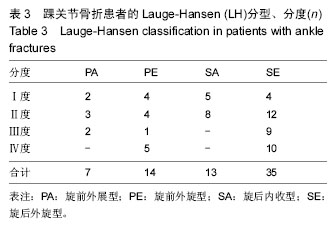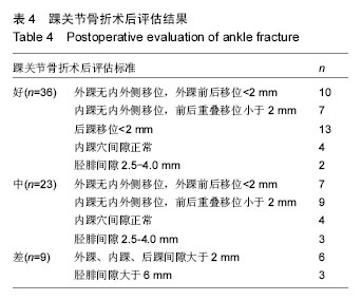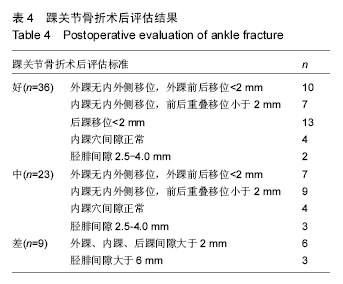| [1] Connors JC, Coyer MA, Hardy MA. Irreducible ankle fracture dislocation due to tibialis posterior tendon interposition: a case report. J Foot Ankle Surg. 2016; 55(6):1276-1281.[2] Kim JH, Gwak HC, Lee CR, et al. A Comparison of Screw Fixation and Suture-Button Fixation in a Syndesmosis Injury in an Ankle Fracture. J Foot Ankle Surg. 2016;55(5):985-990. [3] Nikolaides AP, Anagnostidis KS, Kirkos JM, et al. Inferior dislocation of the proximal tibiofibular joint: a new type of dislocation with poor prognosis. Arch Orthop Trauma Surg. 2007;127(10):933-936.[4] Klaue K. Talus fractures-fractures of the most important tarsal bone. Ther Umsch. 2004;61(7):428-434. [5] Zwipp H. Injuries to the superior ankle joint from the viewpoint of accident surgery. Radiologe. 1991;31(12): 585-593. [6] Nicholas JA. Ankle injuries in athletes. Orthop Clin North Am. 1974;5(1):153-175. [7] 华勇.螺旋CT三维重建在踝关节骨折分型及治疗中的应用[J].中国误诊学杂志志,2012,12(5):1078-1079.[8] 王虎,温晓东,张堃.踝关节骨折治疗新进展[J].国际骨科学杂志,2015,36(6):390-393.[9] Chun KY, Choi YS, Lee SH, et al. Deltoid ligament and tibiofibular syndesmosis injury in chronic lateral ankle instability: magnetic resonance imaging evaluation at 3t and comparison with arthroscopy. Korean J Radiol. 2015;16(5):1096-1103. [10] Kim YS, Kim YB, Kim TG, et al. Reliability and Validity of Magnetic Resonance Imaging for the Evaluation of the Anterior Talofibular Ligament in Patients Undergoing Ankle Arthroscopy. Arthroscopy. 2015;31(8):1540-1547. [11] Loriaut P, Casabianca L, Alkhaili J, et al. Arthroscopic treatment of acute acromioclavicular dislocations using a double button device: clinical and MRI results. Orthop Traumatol Surg Res. 2015;101(8):895-901.[12] Rammelt S, Obruba P. An update on the evaluation and treatment of syndesmotic injuries. Eur J Trauma Emerg Surg. 2015;41(6):601-614.[13] Wang A, Mackie K, Breidahl W, et al. Evidence for the durability of autologous tenocyte injection for treatment of chronic resistant lateral epicondylitis: mean 4.5-year clinical follow-up. Am J Sports Med. 2015;43(7): 1775-1783. [14] Lao LF, Zhong GB, Li QY, et al. Kinetic magnetic resonance imaging analysis of spinal degeneration: a systematic review. Orthop Surg. 2014;6(4):294-299. [15] Grassmann JP, Hakimi M, Gehrmann SV, et al. The treatment of the acute Essex-Lopresti injury. Bone Joint J. 2014;96-B(10):1385-1391. [16] Blanke F, Loew S, Ferrat P, et al. Osteonecrosis of distal tibia in open dislocation fractures of the ankle. Injury. 2014;45(10):1659-1663.[17] Delco ML, Kennedy JG, Bonassar LJ, et al. Post-traumatic osteoarthritis of the ankle: a distinct clinical entity requiring new research approaches. J Orthop Res. 2016. |
